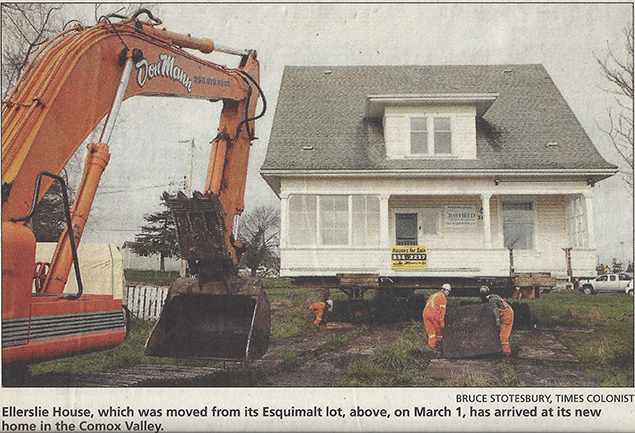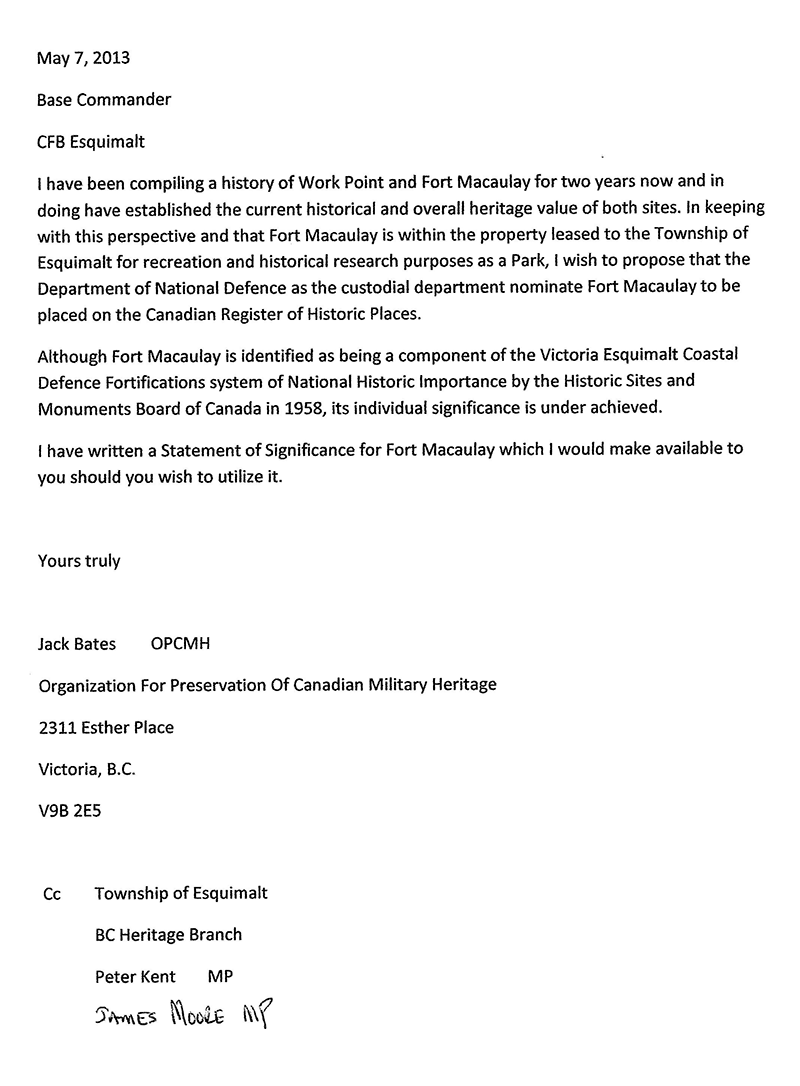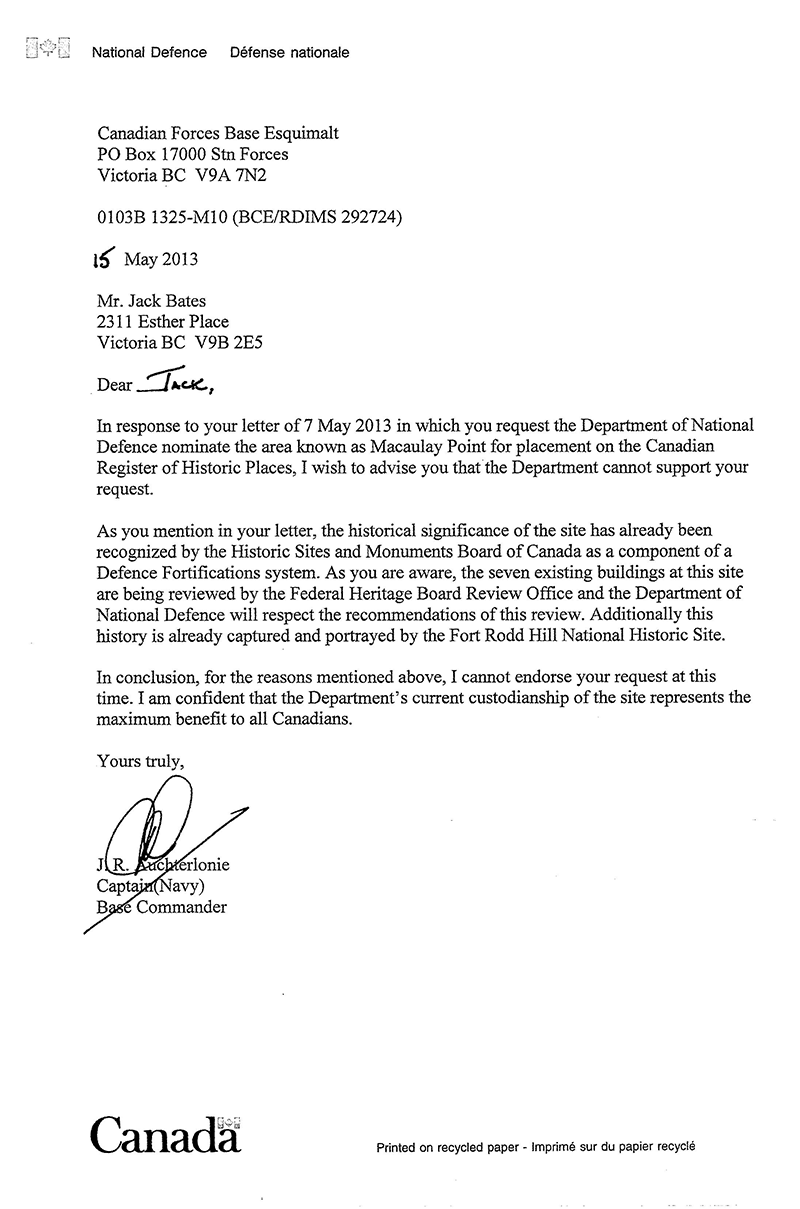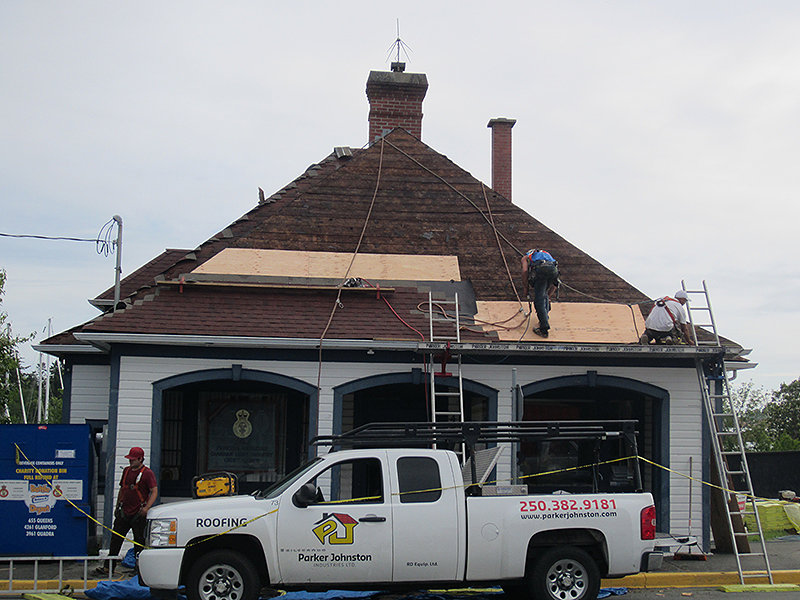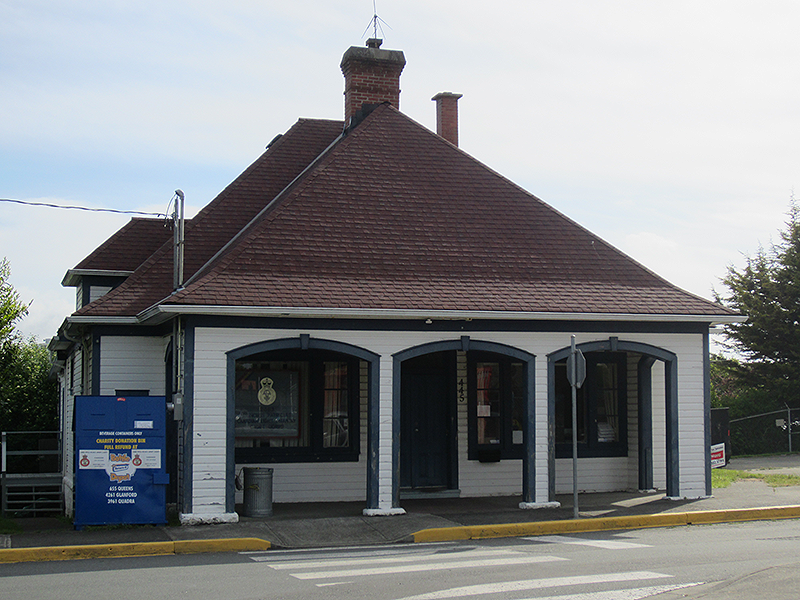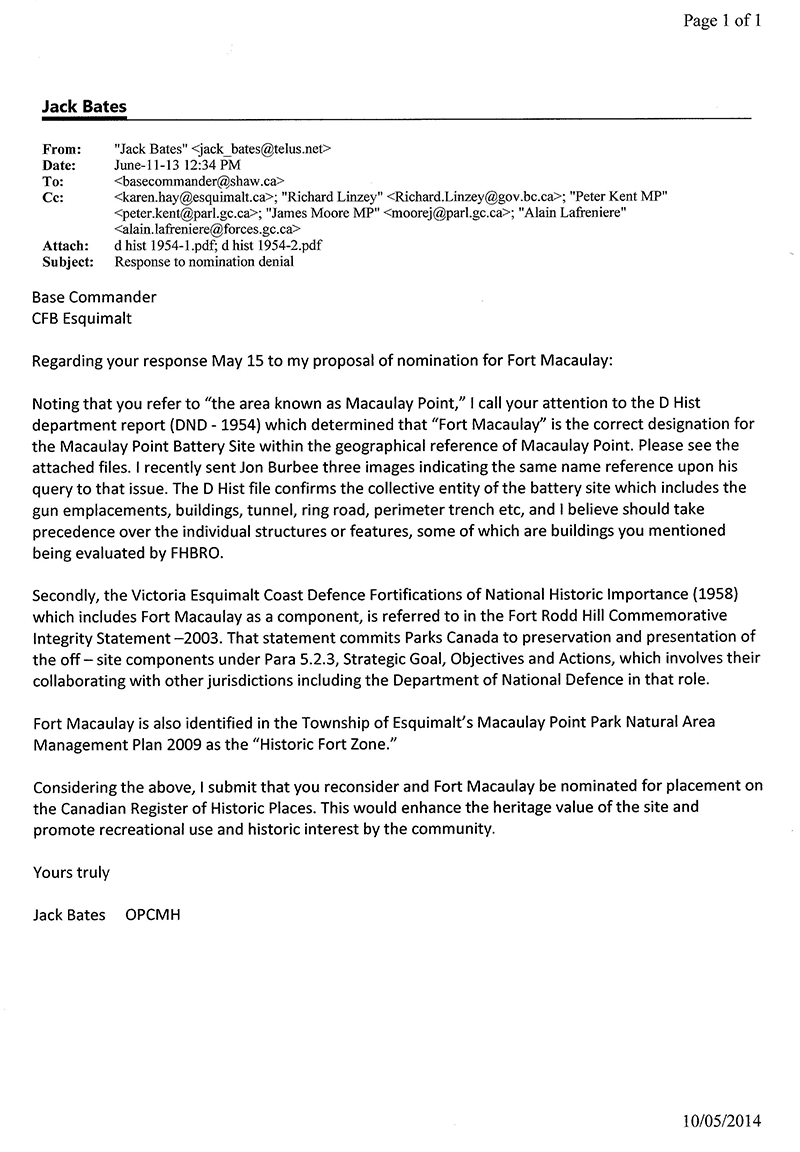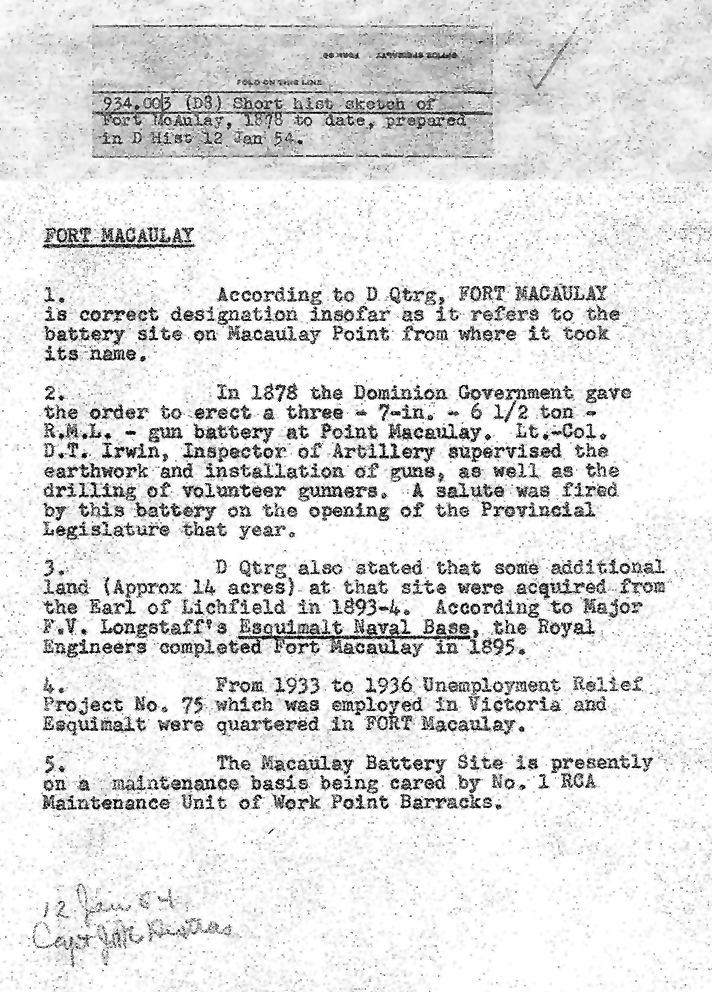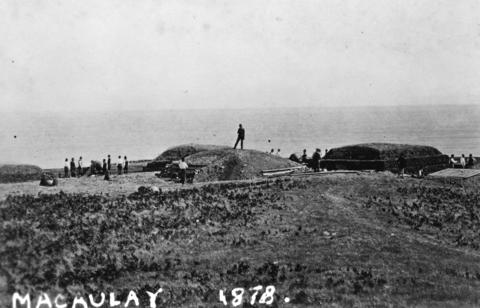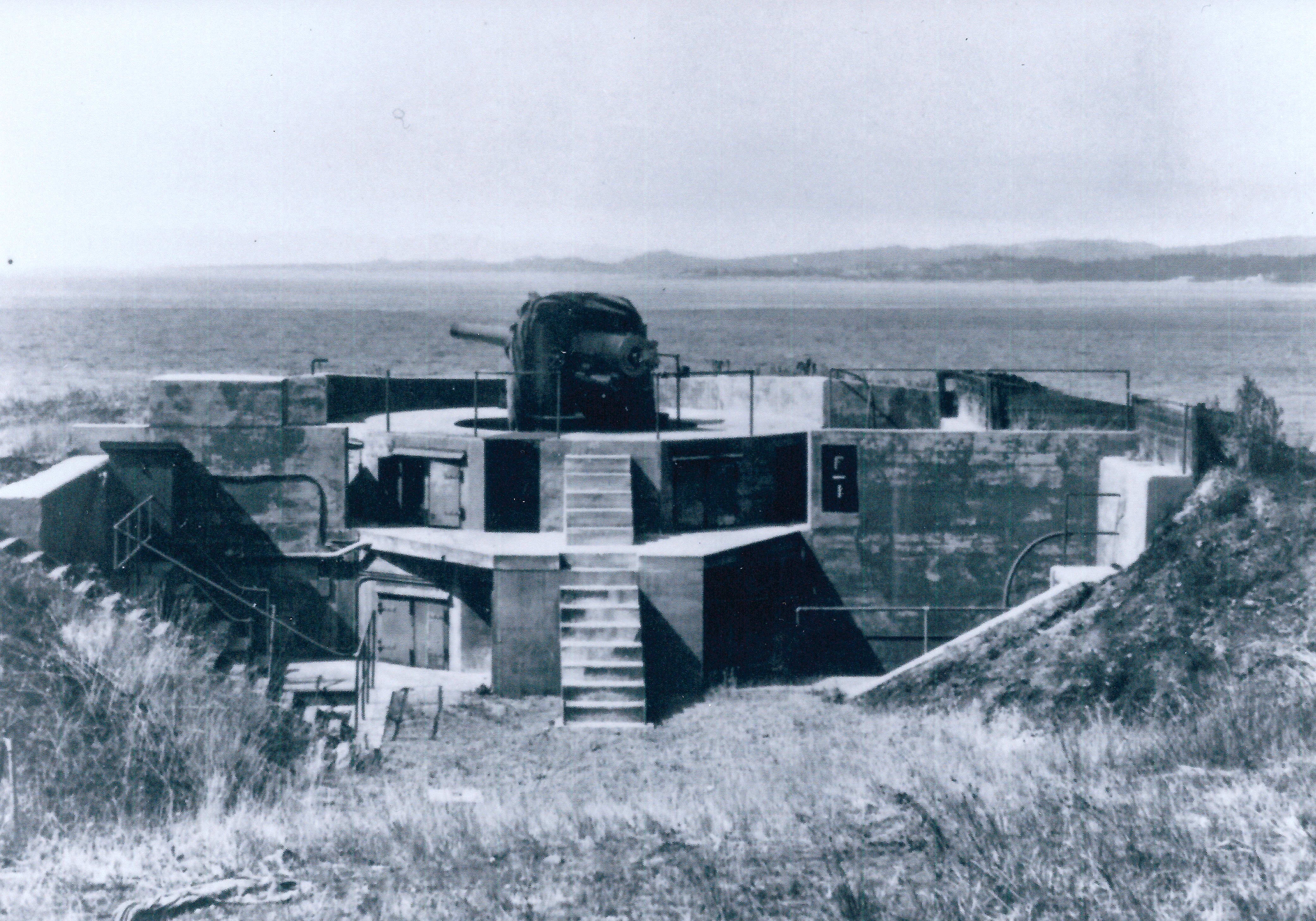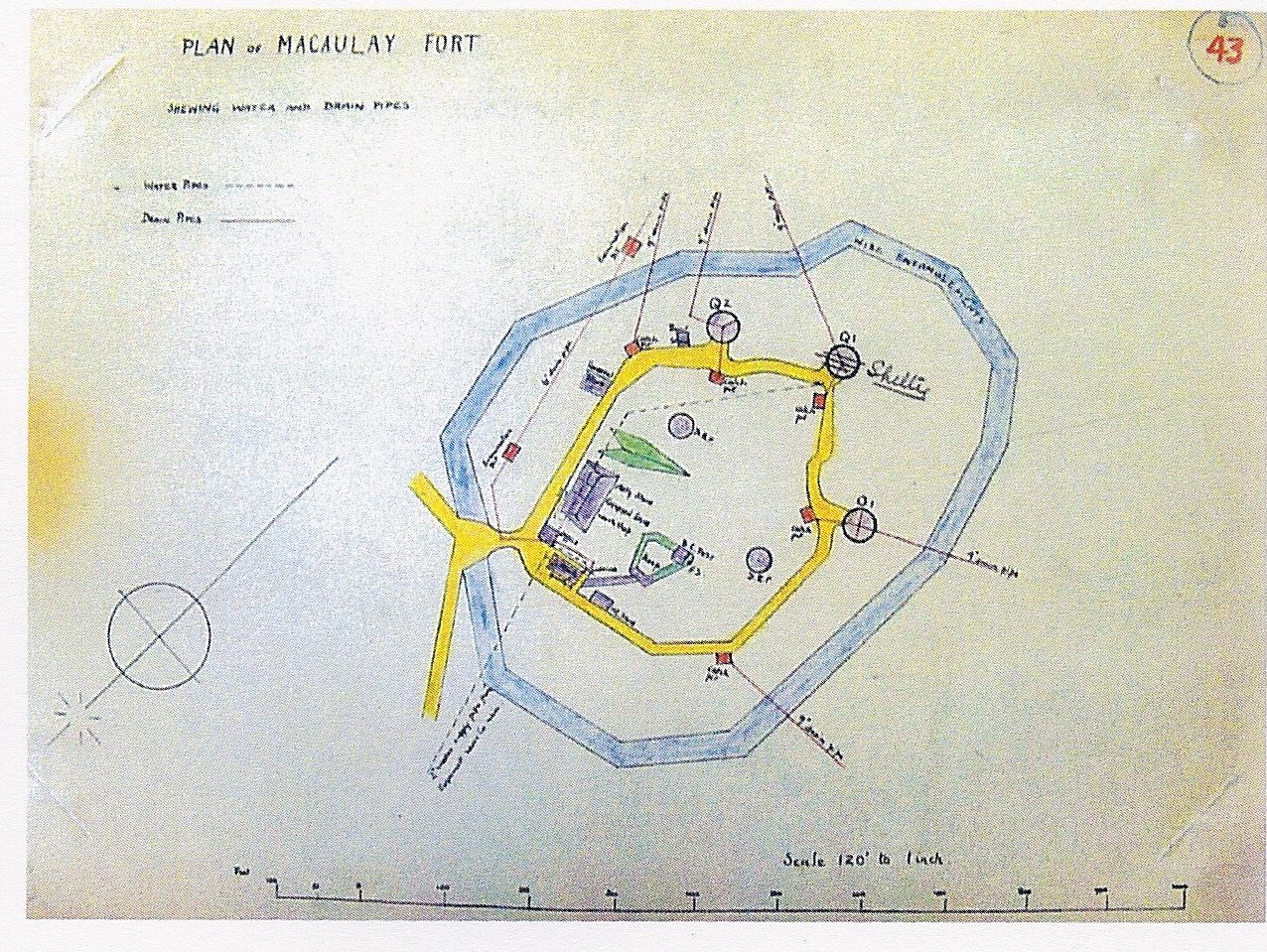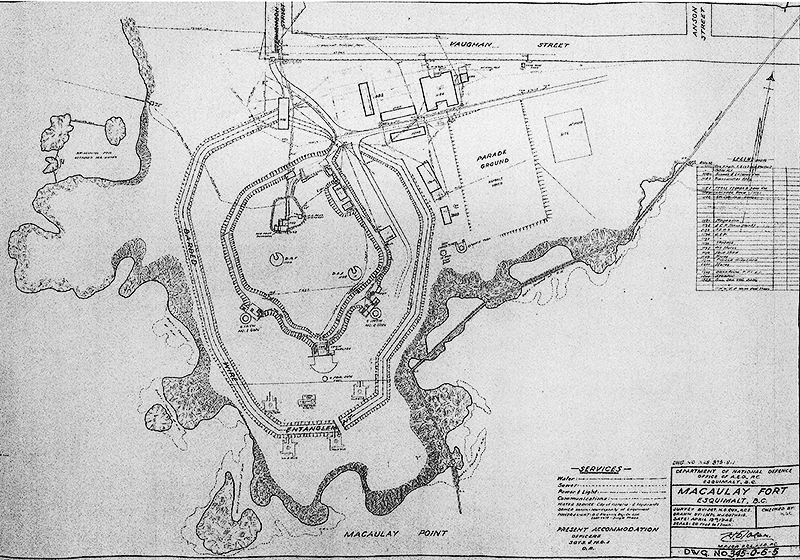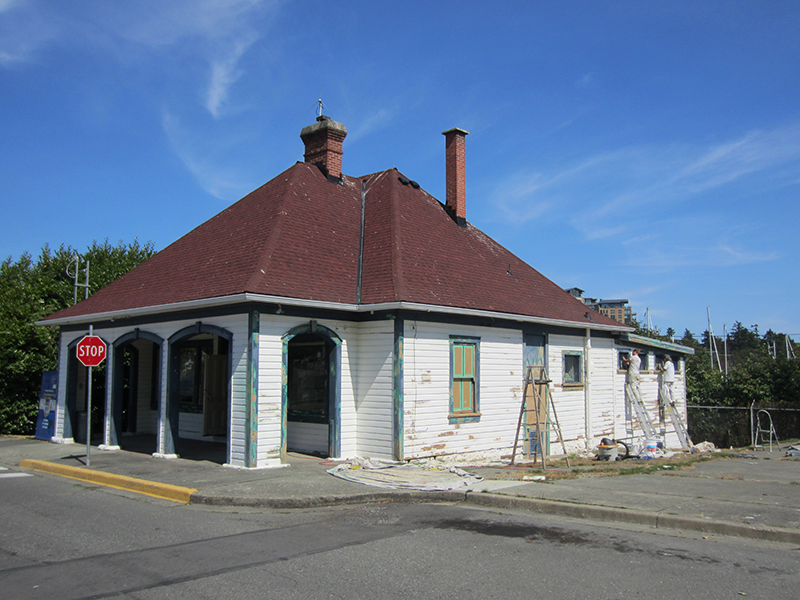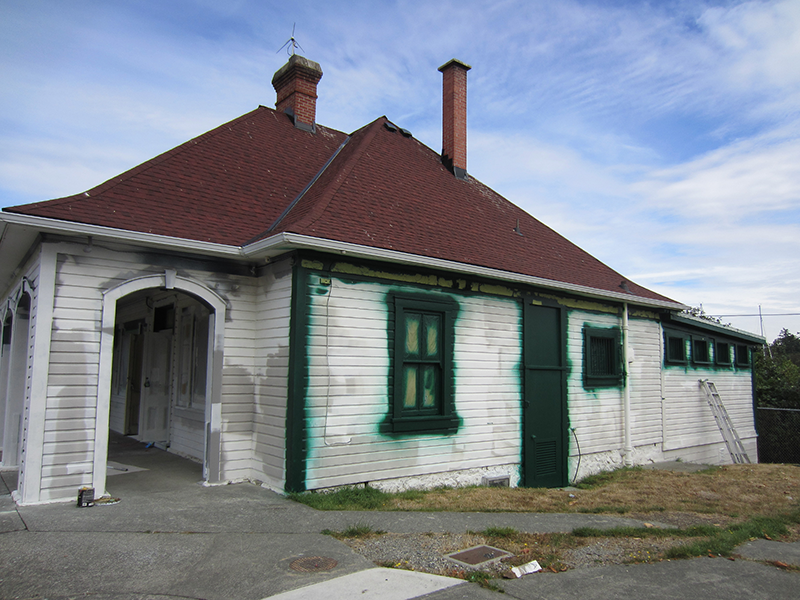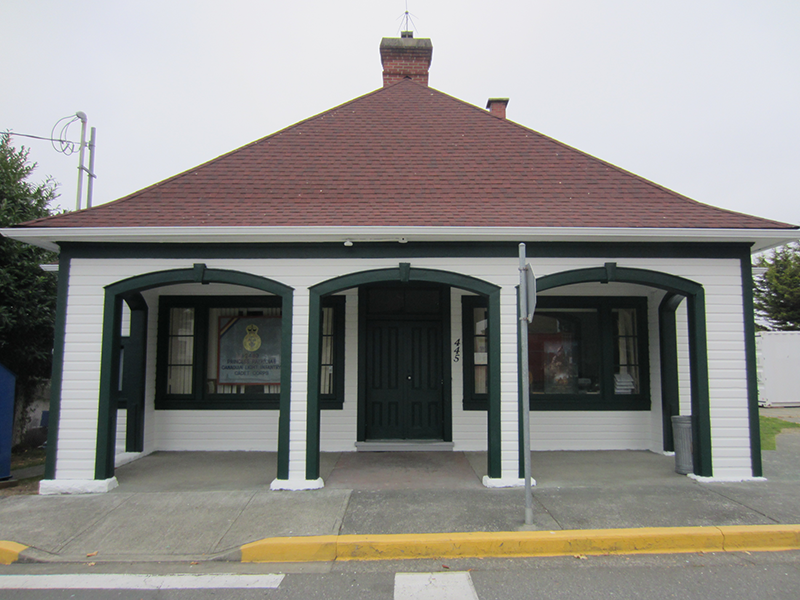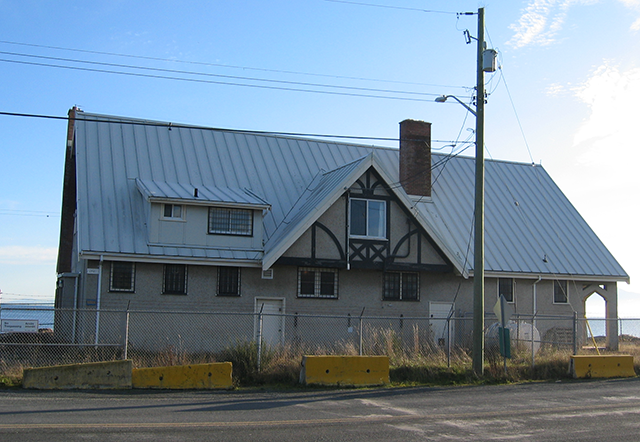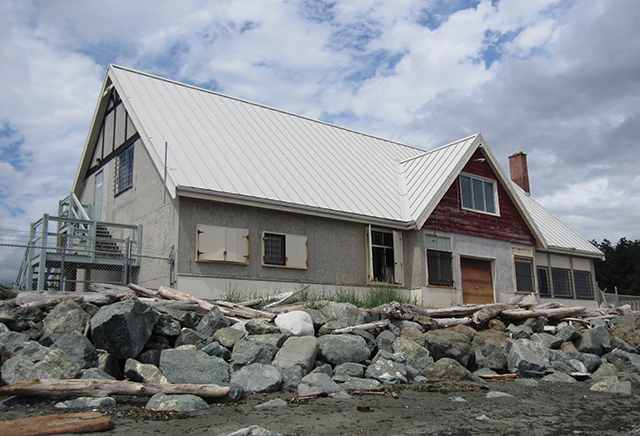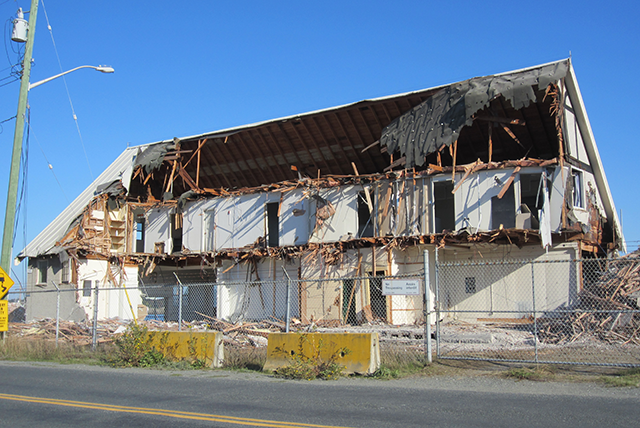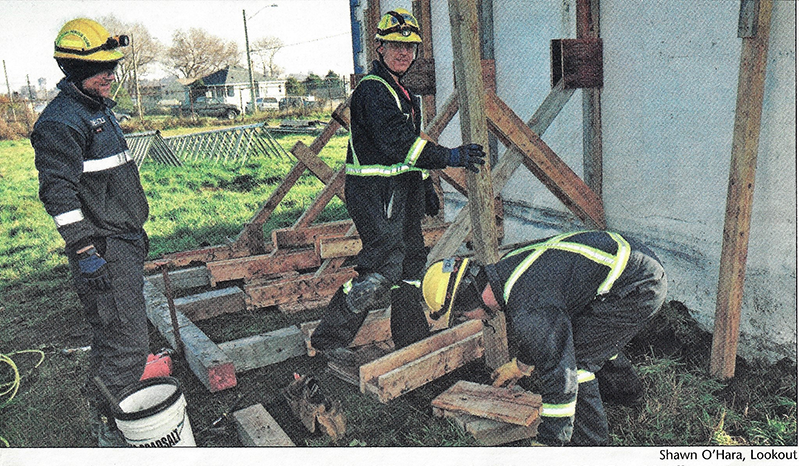 |
 OPCMHVisitor No.: |
HISTORY OF WORK POINT BARRACKSby Jack BatesPART 10 — 1995 to 20222013January 29, 2013 941 Clent St, one of the 14 civilian houses expropriated in 1942, remains empty to date, although some roof maintenance was done. February 17, 2013 The 343 – 353 Anson St Six Block PMQ, built in the early 1950’s, was demolished and the site cleaned up. This building had been contaminated and had sat empty for a couple of years. This building was a generic PMQ styled building and as such had no heritage reference. OPCMH I submitted Fort Macaulay to the Heritage Canada (Top Ten Endangered Places List) and received notice of the submission on March 14th. There was no further follow up. Goldstream News Gazette SURPLUS DND BUILDING FLOATS AWAY TO NEW HOME An island couple have come to the rescue of a DND heritage home previously slated for the scrapyard. The property, located at 316 Anson St. near Macaulay Point, is the former home of John Jardine, Esquimalt’s representative in the Provincial Assembly from 1907 to 1912. The heritage committee for the Township of Esquimalt cried foul in September when Parks Canada said the building didn’t qualify for heritage protection and it was placed on DND’s surplus inventory list. But early Monday morning, the three storey wood-framed structure was loaded onto a barge and towed to a half-acre lot between Buckley Bay and Union Bay. The Parks Canada reference was queried by a local Parks Canada official but was not concerned when he realized that the FHBRO (Federal Heritage Building Review Office) was the intended department.They should be curious though, as the FHBRO evaluation process predictably scored just under the required 50 points to afford a level of heritage status that requires enhanced involvement when disposing of surplus property, a scene common for at least the Work Point buildings and possibly Fort Macaulay structures. The operation is nothing new for buyers Ben and Jen Ford. This couple have replanted six heritage houses along east coast of Vancouver Island since 2006, including their current home in Union Bay, which originated in Vancouver’s Dunbar neighbourhood. “We’re pretty unique in what we do,” Ben said. “Years later, you look back and realize it’s very different than what most other people call a profession.” A key factor on moving the home ws in purchasing a lot close to the water, he added. Because of the building’s height, BC Hydro crews were on hand Friday to remove electrical obstacles as house movers Nickel Brothers wheeled the structure toward the shoreline at Macaulay Point. “The DND was wanting to remove the house one way or another, so we did about two months of work in about a week and a half,” said Ben. Biological and geotechnical surveys had to be completed on a creek bed running through the Buckley Bay property, and the couple were responsible for readying the interior of the house for the move. Jack Bates, a military heritage advocate who fought to save the building, said he’s glad the Fords came forward with a compromise. “If it can’t stay on site with some form of enterprise to make it pay for itself…at least it’s being relocated,” he said. The home features first-cut pine and fir flooring, a split staircase and four original fireplaces. It was most recently used as a child-care facility for DND staff, according to federal documents. “It’s a win-win for everybody,” Ford said. “The DND gets the house out of there in a politically correct manner, the Hallmark Society is happy and it wasn’t destroyed and we’ve got an amazing project to work on.”
Nickel Brothers driver starts up his truck in preparation to move a house from 316 Anson St. on Department of National Defence land to a barge at the shoreline near Macaulay Point. The building was towed up island to Buckley Bay on Monday. It was a beautiful 4 am morning when the house was loaded onto the barge at the Macaulay Plains beach and sailed away in tact “into the sunrise.”
LETTERS ESQUIMALT HERITAGE ADVISORY March 12, 2013 (Rev. April 17) RE: PROPOSAL TO SUPPORT AND PROTECT HERITAGE VALUES OF FORT MACAULAY The intention of this correspondence is to request the HAC to promote and raise the heritage profile of Fort Macaulay, sometimes referred to as Macaulay Point Battery, as a Historic Place within the Township of Esquimalt. This would require the support and cooperation of the Township, the DND and Parks Canada. A revived identity would enhance the presence of Macaulay Point Park, maintain the historical integrity of the Fort, and ensure that destruction of the individual structures would not happen. History
Township of Esquimalt/DND
Parks Canada
Previous Reports/Studies/Publications
Current Condition
Current Activity
Yours truly Jack Bates Encl (7) Times Colonist HISTORIC ESQUIMALT HOME TAKES UP NEW RESIDENCE COMOX: A historic, 116-year-old home saved from demolition is starting a new life in the Comox Valley, trucked to its new lot in Buckley Bay after arriving on a barge. The “Ellerslie” is a Victorian farmhouse built in 1897 for John Jardine, who served as Liberal MLA for Esquimalt from 1907 to 1912, and his wife. The couple lived in the house until 1937, when Jardine died. His wife lived there until 1940, at which time it is believed that the Department of National Defence took possession of the home. It has since been used for a number of purposes, but never again as a single family home, until now.
“It’s quite a grand home inside, with 10 foot ceilings and four fireplaces” said new owner Ben Ford, who plans to move into the Ellerslie with wife Jen and their four daughters. “We just fell in love with it.” The Fords purchased the house from house-moving company Nickel Brothers. It’s the second house the pair has moved to the Comox Valley and the sixth that they have moved in their lives. The Comox Valley is fast becoming known as an ideal destination for century old heritage homes. The Ellerslie is the third home to be moved to the area in less than a year. Last July, the Fords moved a house, built in 1915, from Vancouver to Union Bay. Though the Fords have made a business out of moving, renovating, and selling heritage homes, they had planned to stay in the Union Bay house for a long run, but when they laid their eyes on the Ellerslie, that all changed. “We love the house that we’re in in Union Bay, but we have four girls. It has become too tight. The new house is quite a bit larger,” Ford said. Once renovated, the four bedroom home will have more than 3,000 square feet of living space. It also sits on a large lot. Jim Connelly of Nickel Bros. said it’s no wonder the Fords want to live in the Ellerslie. “It’s a beauty,” he said. “It’s just a really elegant building.” But despite its charm, the home was no longer wanted by DND, which contracted a company to demolish it. Instead, the demolition company called Nickel Bros. “Every once in a while, they see one and say, “This is probably one that Nickel Bros. should look at,” Connelly said. Nickel Bros. was able to work with DND to buy some time to find a buyer for the new home to save it from being demolished. “We almost lost this one a couple of times because it just wasn’t lining up,” said Connelly. Although there were a number of offers on the house, the Fords were lucky enough to find a suitable property that could accommodate the large home. What would normally take months, locating the lot, getting the permissions, arranging the move and getting the financing in place, was completed in just two weeks because DND was in a hurry to free up the land. Once all the administrative work was out of the way, the move itself went smoothly and despite some minor difficulty getting the large building over a wet, mushy field in Victoria, the house arrived in good shape. “The public is really behind this,” said Connelly. Who added that people are generally good natured about inconveniences such as power outages and road closures because they are in favour of diverting old houses from landfills.”
Ellerslie House, which was moved from its Esquimalt lot, above, on March 1, has arrived at its new home in the Comox Valley. These two articles highlite the tale, but there is more to “The Rest of The Story,” and likely more to come when dealing with heritage issues in Work Point where the FHBRO evaluation produces a score “just shy” of the 50 points needed to afford a level of heritage status. COLONIST DND APPEARS TO HAVE NO MANDATE TO PRESERVE HERITAGE In the wake of DND (CFB Esquimalt) fast tracking their wish to demolish yet another heritage building in Esquimalt (see TC Mar. 8 – History on the Move, Mar. 8 – Surplus DND building floats away to new home. Mar. 19 – Historic Esquimalt home takes up new residence in Comox Valley) we, the tax payers of this goliath, get to have little time and little say in the decision-making process. Originally this fine 116-year-old house called the Jardine house was a property within the Township of Esquimalt, but at one time at the beginning of the war it and the land around it was expropriated to Expand Work Point by DND, now that the war is over and the land and buildings are deemed “surplus”, why can’t this land be returned to Esquimalt, and because the heritage initially belongs to Esquimalt, why can’t the Township have their heritage building back instead of helplessly seeing it demolished. If it wasn’t up to some fast thinking civilians resourceful enough to work with DND’s almost impossible time constraints, and move the building off the site, DND would have had it go to the landfill. Over the last 15 years, DND has demolished over 15 buildings, mostly wooded and most a century or more of collective heritage lost with them, one glaring example was Work Point’s Officer’s Mess and Quarters. All these buildings were assessed one by one, which leaves out the possibility of the site being assessed collectively as a Historical Precinct, that is where the Heritage value truly exists. One has to question why they are doing this when the buildings aren’t in the way of any Base operations, and why the rush to take them down? A number of local historians are keeping an eye on “Fortress Macaulay” as well. The DND is presently having the buildings and gun installations there assessed one by one, which means they may go on the chopping block next. As one local architectural historian said; “It’s a mandate issue, pure and simple, DND has no mandate to preserve heritage.” (in reference to Work Point). Colin MacLock Quote from: Heritage Canada Magazine – Summer 2006 page 6, 2nd paragraph – Donald Luxton. Esquimalt Heritage Design Guidelines Final Report CRG Consulting (Ottawa) CFB ESQUIMALT DOCKYARD, SIGNAL HILL, NADEN, WORK POINT This report materialized on March 28, 2013 to the surprise of everybody in the heritage community in Esquimalt and Victoria even though there was involvement by the local DND and representatives from the Department of National Defence in Ottawa on several occasions with meetings held in Esquimalt starting in January 2011 with the final meeting in February 2013. There was no consultation with the Township of Esquimalt although a DND representative had visited the Archives in search of historical material. Upon reading the report, with knowledge of CFB Esquimalt’s historical structures and publications, it became obvious that the report was fabricated to eliminate certain buildings in Work Point Barracks. The report excluded FHBRO report 89-205 on Work Point buildings including its history, included 89-202 for the Dockyard and 89-203 for Signal Hill as they supported their respective heritage values. Also not included were two other heritage building reports for Work Point, the NOTC Phase II 2001 heritage report and the 1974 CFB Esquimalt heritage building review by Stevenson and Kellogg, for the DND. These reports all advocated the heritage values of the Work Point buildings. Within the original Work Point footprint are currently buildings: # 1004 (1888) Barracks, Recognized; #1020 Headquarters (1898 and rebuilt 1918) Recognized but not identified as such; a cultural landscape “C” Battery field gun and saluting platform” (1891) currently commemorative but not previously discussed; and # 1030 (1897) ammunition and powder magazine incomplete report in 89-205. All the buildings are in use while the saluting battery supports two commemorative dedications. One other building, #1031 (1939) also currently in use, is to be retained. The RGA precinct contains four brick buildings: # 1068 (1904) Detention Barracks; #1070 (1902) Stores; # 1071 (1902) Sgt.’s Mess; and # 1075 (1902) Barracks, Recognized. All buildings are currently in use. This precinct is the proposed heritage zone the report wishes to preserve. One would not know the other “precinct” existed. As well there is no mention of Work Point Point Barracks being a component of the Victoria-Esquimalt Coast Defence Fortifications declared to be of National Historic Importance by the Historic Sites and Monuments Board of Canada in 1958. April 4, 2013 In recent correspondence with an official from the National Real Properties Program in Ottawa regarding 361 Anson house, “if the building is not designated by FHBRO, there is absolutely no obligation to inform the local authorities for demolishing a building situated on Base.” This is a “Bricks and Mortar” attitude at its worst, which is easy from Ottawa, easier for the BCEO to initiate or comply, and so convenient if the FHBRO scores are low. Township of Esquimalt Council Meeting Agenda: Presentations: Jon Burbee, Manager of Real Estate Services, CFB Esquimalt. The Historic Sites and Monuments Act of 1985 was referred to and that the DND will follow the guidelines. Some communication between the Township of Esquimalt and DND followed, however to no avail or future involvements. There is a lot more to this of course and in support of adaptive reuse of historic military buildings in Esquimalt I would like to see more than “moral persuasion” when it comes to dealing with these matters. Esquimalt Council Minutes - Item 5 PRESENTATIONS (2) covers the presentation on the built heritage conservation policy for CFB Esquimalt and Item 11 COMMUNICATIONS (1) covers the March 12, 2013 letter of mine to the council concerning Fort Macaulay heritage. Click here to view the minutes (PDF). OPCMH
BASE COMMANDER
OPCMH I submitted the following to Heritage Canada (Top Ten Endangered Places List):
I received notice of submission on May 21st. There was no further follow up. The Magazine WP 1030 was later demolished without notice by the DND in October 2014. It was part of a “Cultural Landscape” created to honour the Artillery presence in Work Point since 1887. Another example of the DND disconnect with the community. This structure, built in 189,7 was somehow ignored by various reports done for DND although being very clean and sound in status, a mystery only the DND could divulge, good luck with that considering the present C & E attitude. WORK POINT BARRACKS FORMER GUARDHOUSE May 22, 2013 The new roofing on the former guardhouse, building 1001, was completed today by Parker Johnston and retained a similar colour of shingle. Of course roof vents were added.
DECONSTRUCTION LIST Click here to view CFB Esquimalt Facilities Pending or Scheduled for Deconstruction as of January 25, 2013 as a PDF file. Note WP 1030 listed as RECOGNIZED. OPCMH
Esquimalt Council Meeting Minutes
Moved by Councillor Hodgins / Councillor McKie. That the Fort Macaulay site, located within Macaulay Point Park, be added to the Esquimalt Community Heritage Register, and that the Statement of Significance be approved as presented in the attachment to Staff Report DEV-13-031. Carried unanimously. This is the SOS I prepared for the site during 2013, a rewarding venture, in which a lot more was learned about the site. The SOS will be forwarded to the BC Heritage Branch for their inclusion and eventually will reside on the historicplaces.ca web site. Thank you to Richard Linzey and Karen Hay for their assistance. Statement of Significance Fort Macaulay Description of Historic Place Common Name: Fort Macaulay Fort Macaulay is a nineteenth and twentieth century coast artillery defence fortification located on the prominent headland of Macaulay Point, in the Township of Esquimalt, overlooking the entrance to Victoria Harbour and within sight of Esquimalt Harbour. The historic place contains concrete gun emplacements, brick and concrete buildings, an entrance gate, internal ring road with an access tunnel to a command post, and portions of a perimeter defence trench. It is included within “Macaulay Point Park,” a 5.5 hectare (13.6 acres) parcel leased by the Township of Esquimalt from the Department of National Defence for recreational use and historic interest. The site is bounded immediately on the north and east by Department of National Defence (Work Point) lands; on the west by Fleming Bay; and the south by the Strait of Juan de Fuca.1
Heritage Value Fort Macaulay illustrates the Militia defence requirements of the Dominion Government to fulfill the terms of British Columbia entering Confederation in 1871 and reflects a deterrent against the threat of a seaborne attack from Russia or the United States. In 1878, a temporary improvised wood and earthworks battery was built on a 2.97 acre (1.2 hectare) site on Macaulay Point. This land, within the Viewfield Farm of the day, was purchased from the Puget Sound Agricultural Company, a farming subsidiary of the Hudson’s Bay Company. In 1893, in compliance with the defence agreement between the British and Canadian governments, an adjoining 14 acres (5.7 hectares) were purchased to allow for the construction of an extensive permanent fort to protect a battery of coast artillery guns, thereby ensuring continuing defence adaptability. The temporary battery site was levelled and the new fort was completed in 1895. Fort Macaulay’s historical value is expressed as a component of the Victoria-Esquimalt Coast Defence Fortifications declared to be of National Historic Importance by the Historic Sites and Monuments Board of Canada in 1958. It was the longest serving component of the Victoria-Esquimalt Coast Defence Fortifications System and is referred to in the Parks Canada - Fort Rodd Hill Commemorative Integrity Statement - 2003. Fort Macaulay is valued for its long association with the Canadian Army in British Columbia as it was manned continuously from 1878 to 1956 by local Militia units, Canadian Artillery, interim Royal Artillery, and finally Canadian Artillery units exclusively again from 1906. Notably, Fort Macaulay was used for artillery field training purposes by Canada’s General Sir Arthur W. Currie, prior to and in preparation for World War 1. Fort Macaulay’s heritage value also lies in the integrity and significance of the cultural landscape representable of the “Twydall Profile.” The “Keep,” with a “Redoubt” overlooking the fort, bears comparison with the “York Redoubt,” a National Historic Site near Halifax, Nova Scotia, and with arrangements at the precedent setting “Beacon Hill” fortress in England. Fort Macaulay has additional heritage value due to its collective and relatively intact nature when compared to what currently survives of the other Victoria-Esquimalt coastal defence artillery fortifications.2
The historic place provides an important physical and tangible link to the narrative of the evolving science and technology of British Imperial and Canadian coastal and close defence installations on the Pacific coast. Character-Defining Elements Key elements which define the heritage value of Fort Macaulay include:
The Minute Book The RCR at Esquimalt 1914-1917 In August 1914, the Canadian Government authorized the establishment of a new company station for The Royal Canadian Regiment. No. 6 Station, at Esquimalt, was home to “L” Company of the Regiment, and provided a western location for the Regiment’s Permanent Force recruiting until the end of 1917. The first officer commanding “L” Company would be Captain Edward Seely-Smith, who was in British Columbia en route to Australia and found his travel halted to organize and command the new Company. General Orders 1914 G.O. 125 – Organization G.O. 126 – Establishments 1914-1915
All totals to be amended accordingly’ By command, WORK POINT BARRACKS
Lookout VACANT BUILDING REMOVED The rumble of back loaders and shouts from construction workers heralded a final goodbye to a long neglected fixture by the Esquimalt lagoon. The stout building that once sat at the mouth of the lagoon was recently taken down by a base Construction and Engineering (BCE) team. “It’s always sad to see buildings like this go,” says Sgt. Don Fraser, Contracts co-ordinator for BCE. “However, when it sits empty as long as this building has it’s really not being used to its full potential.” The stucco sided, two story building was erected in 1938 and served as a pub until 1942 when the property was expropriated by the Department of National Defence (DND) and used by Royal Roads. Over the years it served a number of purposes such as married quarters, a station for Canadian rangers patrol groups, and a ship degaussing station run by the Fleet maintenance Facility Cape Breton. Despite its past uses the building has been unused since 2006. “It was decided the cost of maintaining a building that wasn’t going to be used again was too great,” says Sgt. Fraser. “That, along with land erosion, contributed to the decision to bring the building down.” As the site is across the road from a bird sanctuary and borders the ocean, Sgt. Fraser says utmost care was taken to make sure the building fell in the least impacted way. “We basically dug out the building until it came straight down as opposed to falling towards the ocean or across the road,” he says. “It’s very important to DND to protect against negative environmental impact when we go about our work.” While the building no longer remains, its materials will find new life in buildings across the region. Flooring, electrical wiring, metal fabrications, and stone used in the construction will be used by local contractors in other projects. “Recycling during this kind of project is so hugely important,” says Sgt. Fraser. “The more we recycle, the less waste makes it to the landfill. It’s better to go through the extra work of sifting through materials than to deal with the impact of overfilling dumps.” Photo Base Construction Engineering has removed this building, which served as a pub, married quarters, and a degaussing station at one time in its long life near Esquimalt lagoon. Another case of the FHBRO evaluation being just under the score required to reveal Recognized heritage status. If interested, the DND, as the custodial department, has the option to request a re-evaluation, however this doesn’t seem to happen ! Goldstream Gazette COLWOOD SEEKS DND LAND Foundations Last Remains of Historic Building The City of Colwood is looking to but the land where a landmark department of national defence building once stood. The 1930’s era building near the bridge on Ocean Boulevard sat unused since 2006 and was torn down last week. Department of National Defence says the building had to be demolished because it was in poor condition and was no longer of any use. The cost to repair the building was too much to justify restoring it, as opposed to the cost of tearing it down. The land the building sat on is also eroding, making the building a liability, said Cpt. Jenn Jackson. “It’s in poor condition, it’s expensive to repair,” she said. The building foundations were left, said Colwood CAO Chris Pease, because removal could destabilize the land. Any underground tanks will also be removed or filled. “DND TEARS DOWN “LANDMARK BUILDING” The building was constructed in 1938 after an earlier building burnt down. At one point the site was the home of a pub called The Dugout. DND took over the building in 1942 and used it as a naval college. In the 1960’s it was used as married quarters, lat by the 4 Canadian Rangers Patrol Group and finally as a fleet maintenance facility from 1993 to 2006. Jack Bates, a local military historian, laments that the building was allowed to deteriorate to the point where it could not be feasibly saved. Bates said the building was constructed by a member of the Buxton family, a well known name in Victoria military history. “Unfortunately what happens is they let them sit for so long that they become eglected to a point where their value is decreased,” Bates said. “They should have thought of that when they emptied it out. That’s quite a landmark building, you (could) see it from around Macaulay Point.” With the building down, the City of Colwood started talks with DND in hopes of buying the land. “What we want to do is make the whoe spit a part of a larger park, and this is the last bit that we would like to get a hold of,” Pease said. “So it’s pretty exciting from our perspective.” DND will likely ask for the assessed value of the property, but Pease hopes that because the land would go to public use, and has a limited lifespan due to erosion, a deal may be sorted out.
A “Landmark” National Defence building at Esquimalt lagoon comes down after years spent empty. The City of Colwood is considering the land for part of a public park. FHBRO Report on the above pictured Dugout/Guardhouse September 22, 2013 Dar Purewall, Chair Now that Fort Macaulay is on the Township of Esquimalt’s Heritage Registry, I would like to formally offer to the committee an opportunity to visit the Fort. With a week’s notice I will guide and interpret the site for any members wishing to do so. This would take approximately one and a half hours. Also, as Work Point Barracks is more of a topic lately, I offer the same opportunity. Work Point is an open part of the Base and I have permission to do so. A mini tour of Work Point “proper” would take approximately forty-five minutes and cover the lands and buildings bounded by the former Guardhouse at 445 Head Street, Lyall, Peters and Malvern Streets. As you are aware there are three FHBRO “Recognized” buildings on this site. I will be available after October 19th, 2013. Yours truly Jack Bates DEPARTMENT OF NATIONAL DEFENCE My request to the DND for the pre-demolition Heritage Record of building 1027 was received. However, it did not contain written or graphic records as were properly included in the Heritage Record for the Guardhouse, building 1001, which was an excellent complete record done by Transport Canada. The photos of 1027 were taken in September of 2002 and can be found in the Base Museum files. I believe the FHBRO didn’t engage properly here. LOOKOUT PO 2 Robyn Jutras composed a Centennial Marching Song for the PPCLI 100th Anniversary. The LOOKOUT article details the production. CD’s were available of this very popular marching song.
October 31, 2013 Painting of the exterior of the former guardhouse, building 1001, was completed today by Empress Paint, the white colour repeated but the trim was repainted in forest green, the oldest original colour determinable. This of course was the Army colour of the past number of decades. The new roof and painting of the exterior has revealed a much more vibrant landmark appearance of “The Guardhouse.” Next on my list is an estimate and approval from the owners for attic insulation and a driveway into the adjacent parking area. The Township of Esquimalt kindly prepared an engineering drawing for a driveway in October 2012, of course so they should after returning the $10,000 to Transport Canada which had been given to the Township for repairs to the roadway along the frontage of 445 Head street, now in their jurisdiction. By the end of 2013 there were no obvious changes to the structures at Work Point or Fort Macaulay, even though the CRG report was issued, and while the FHBRO study on the Fort Macaulay structures has not been finalized or made available. November 4, 2013 In the light of several historic buildings in the City of Victoria being redeveloped in situ rather than demolished, the former Work Point Barracks Guardhouse is an example of the same adaptive re-use principle taking place within the Township of Esquimalt. The 1891 built Guardhouse, sold to Xhamasung Holdings LLP in 2005, was unoccupied for eleven years after 3 PPCLI relocated out of Esquimalt in 1994. The building is now leased coincidentally by the PPCLI Army Cadet Corps and utilized as their headquarters and training center. In 2010 the owners placed a new water service and this past year reroofed the building and repainted the exterior. They hope to have repairs done to the frontage roadway as funds for such work ($10,000) was provided by Transport Canada at the time of the sale. The Guardhouse currently carries a Statement of Significance approved by the Township and is on the Esquimalt Heritage Registry. It was previously a FHBRO heritage "Recognized" building. It is hoped that as other FHBRO "Recognized" and historic buildings and landscape features within Work Point Barracks proper become unused, declared surplus or subject to demolition, that they would be retained, or afforded an opportunity for public/community involvement. And, by comparison, not suffer the same neglect and demolition fate as the "Recognized" Officer's Mess in 2006. Yours truly Jack Bates LOOKOUT CIVILIANS TRAIN FOR CATASTROPHE RESPONSE On top of a pile of rubble, amidst the clanging of sledgehammers and the pounding of nails, 25 people train for the worst. They’re a part of the CFB Esquimalt’s Urban Search and Rescue (USAR) annual training, and right now they’re stabilizing a “collapsing” building. “Simulations and scenarios help give the training a more practical edge,” says Glenn Cooper, USAR Team Commander. “When they have a clear goal ahead of them it’s easier to put their training and techniques to the test.” Standing in for the collapsed building is an old concrete shed at the USAR facility at Work Point. Temporary shoring materials are being erected using wooden beams, steel pegs, nails, nail guns, sledgehammers, and saws. “This is a vert basic skill for USAR. Obviously, it’s not safe trying to get people out of a building about to fall on your head, so you have to make it safer,” says Cooper, who has been with USAR since 1999. Building stabilization is just one part of the two-week long program. Trainees also learn the basics on breaching, the use of heavy tools to break through wooden, concrete, and even metal walls in the event someone is trapped inside a structure. “There are myriad skills needed in an USAR situation,” says Cooper. “With this team training we hope to lay the groundwork so they are better prepared when we send them for certification training.” The training draws personnel from across DND, civilian and military. For PO 1 Dan Moeller the training is a way of ensuring his skills are up to snuff should the real thing ever happen. “We’re taught if anything actually goes down to ensure our family and immediate community is safe before anything else,” says PO 1 Moeller, Senior Electrical Technician aboard the HMCS Ottawa. “If, unfortunately, anything were to happen I want to make sure I have the skills I need to keep people safe.” With a mechanical mind, PO 1 Moeller says the training has been great for expanding on his skills as well as giving him a hands-on chance to use them. “Working together on the tasks and scenarios has given me a good look at what it’s actually like to use these skills,” he says. With the training now behind him it’s back to work as usual for PO 1 Moeller, but he says the training is something he’s happy he got and won’t soon forget. “This kind of situation isn’t something we’ve had to deal with yet, but it could really happen any day,” he says. “I know people who don’t even have Earthquake Kits. It’s easy to forget about it but we have to be prepared to protect our families, our communities, and our region.”
Similar training was offered to Esquimalt residents in the Fall 2013 issue of the ESQUIMALT EMERGENCY PROGRAM, called the “Light and Urban Search and Rescue” program (LUSAR). DEPARTMENT OF NATIONAL DEFENCE Response to my request to DND for correspondence regarding building 1027 between Nickel Bros. and the DND. I had contacted Nickel Bros. in December 2009 on this same topic. Their response was “A client from Lopez Island, Washington, placed an accepted offer on then building. The delivery location was not acceptable to the Department of National Defense, which deemed that relocation of the building on a property in the U.S. was not in the best interest of the general public of Canada.” Nickel Bros. successfully relocated building 1043 (Flanders Building) from Work Point to Hornby Island in 1998 and the Jardine House, 316 Anson Street, also barged to Buckley Bay at high tide, in March of 2013. |
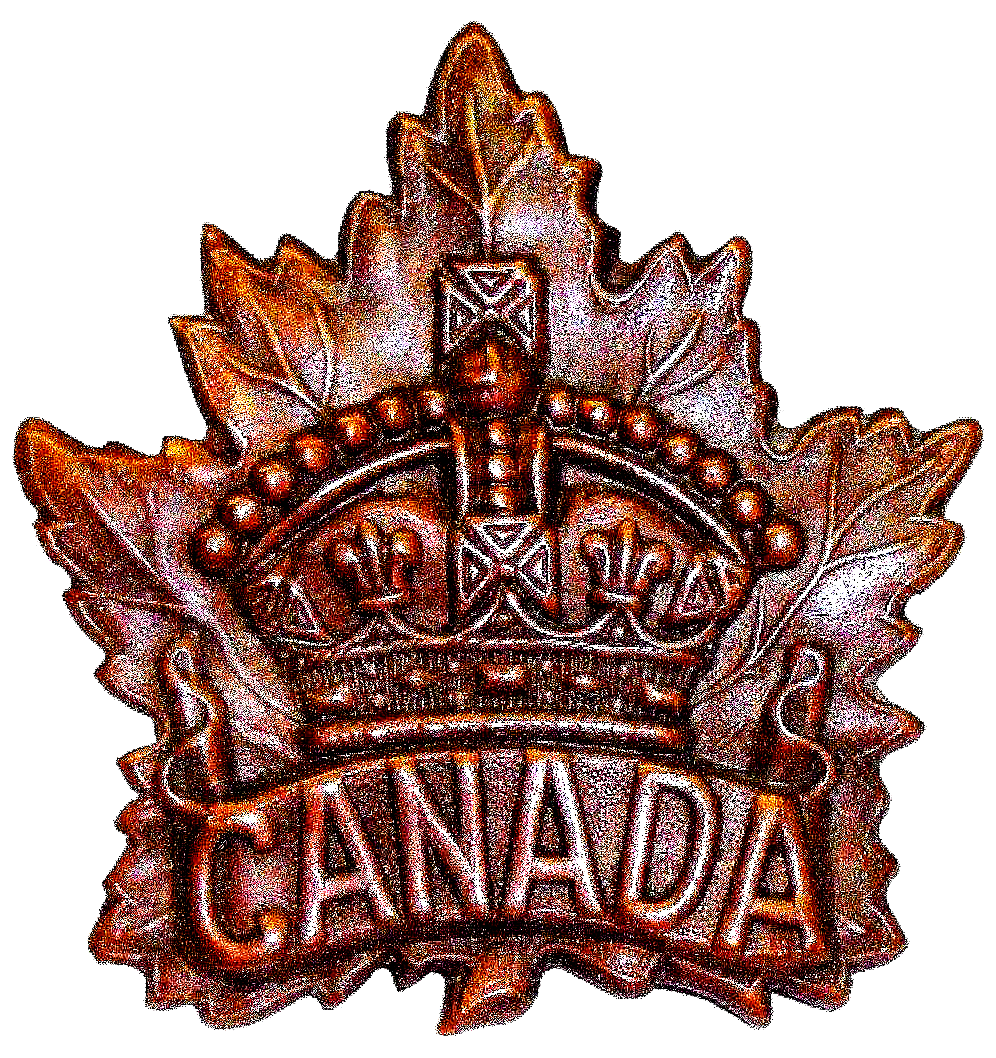
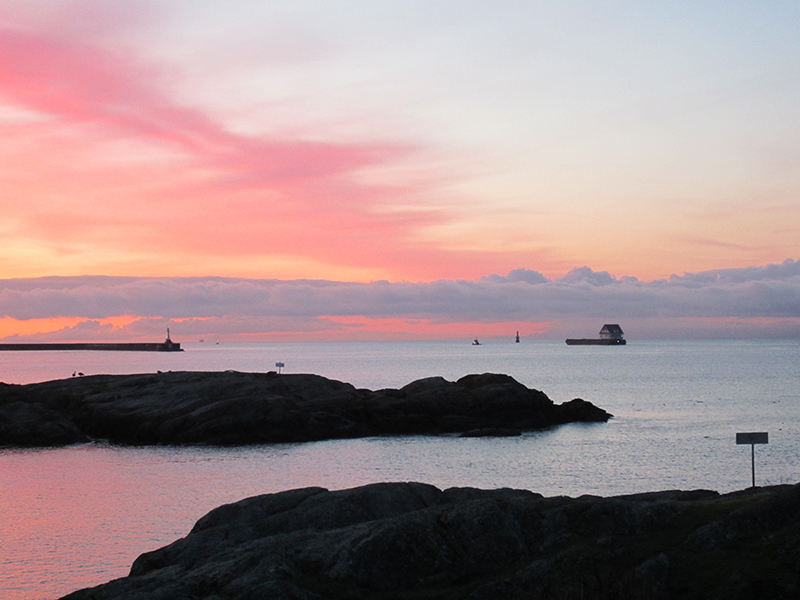
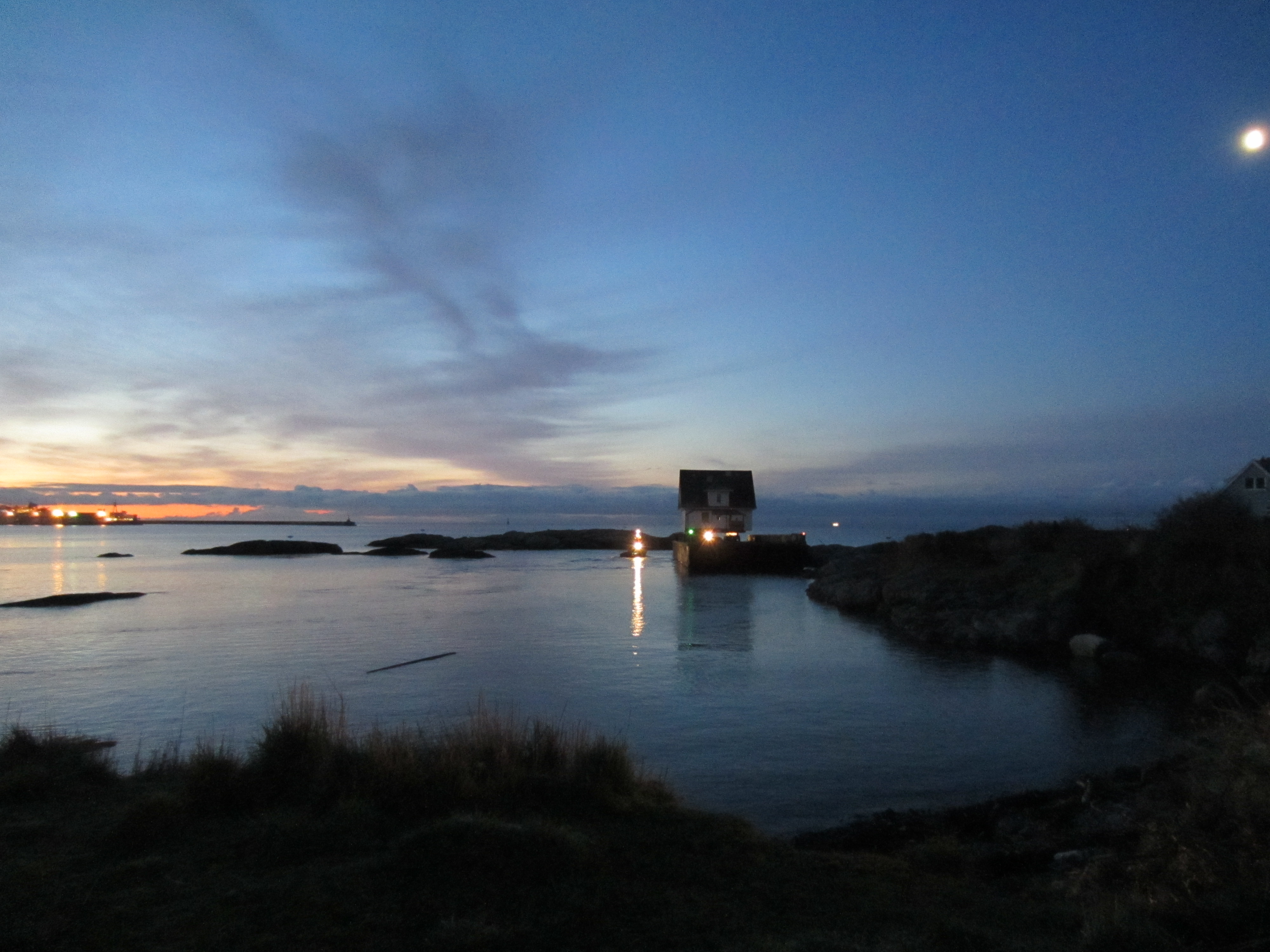
.png)
